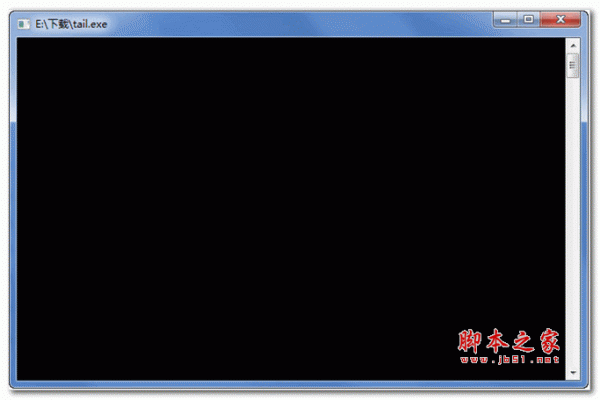Tail For Windows文件命令编程工具是一个免费使用命令行实用程序能够显示一个文件的最后一行以及监控文件的修改(如日志)。它也可以捕捉任何指定数量的文件,为了把它变成另一个文件。命令从指定点开始将文件写到标准输出.使用tail命令的-f选项可以方便的查阅正在改变的日志文件,tail -f filename会把filename里最尾部的内容显示在屏幕上,并且不但刷新,使你看到最新的文件内容.
功能说明它支持大多数UNIX / Linux系统兼容的命令。下载的软件包包括CLI的可执行文件,以及一个经验不足的用户帮助手册。
使用的语法是:尾[ F ] [ C | B | K L M | | | N + / - ] [数]的[文件]和[数]尾+ C | B | K L M N | | | [F] [文件]和尾[民] C | B | K L M N | | | [F] [文件]
调用应用程序的过程中没有任何命令将显示指定的文件最近的10线。除了“F”,用来监视文件的变化,所有的选项是互斥的。
and +/-[num]b" displays the file in question starting with the location defined by "num". " style="font-family: museo_sans_cond, Arial; font-size: 16px; letter-spacing: -0.100000001490116px; line-height: 21px; white-space: normal; background-image: initial; background-attachment: initial; background-size: initial; background-origin: initial; background-clip: initial; background-position: initial; background-repeat: initial;">例如,“B [±]数字>和+ / - [民] B“显示文件中的问题开始的位置定义的“民”。加“-”符号“民”指示工具揭示过去的数块文件。否则,如果“-”替换为“+”,程序显示文件从指定的块(一块是512字节)。
此外,“C [±]民”和“+ / - [民] C”与“B”的选择,而唯一不同的是,“民”是不是时钟字节表示。
剩下的选项以及实例和可能的退出状态值在产品手册中提供。
展开收起软件说明1.命令格式;
tail[必要参数][选择参数][文件]
2.命令功能:
用于显示指定文件末尾内容,不指定文件时,作为输入信息进行处理。常用查看日志文件。
3.命令参数:
-f 循环读取
-q 不显示处理信息
-v 显示详细的处理信息
-c<数目> 显示的字节数
-n<行数> 显示行数
--pid=PID 与-f合用,表示在进程ID,PID死掉之后结束.
-q, --quiet, --silent 从不输出给出文件名的首部
-s, --sleep-interval=S 与-f合用,表示在每次反复的间隔休眠S秒
4.使用实例:
实例1:显示文件末尾内容
命令:
tail -n 5 log2014.log
输出:
[root@localhost test]# tail -n 5 log2014.log
2014-09
2014-10
2014-11
2014-12
==============================[root@localhost test]#
说明:
显示文件最后5行内容
实例2:循环查看文件内容
命令:
tail -f test.log
输出:
[root@localhost ~]# ping 192.168.120.204 > test.log &
[1] 11891[root@localhost ~]# tail -f test.log
PING 192.168.120.204 (192.168.120.204) 56(84) bytes of data.
64 bytes from 192.168.120.204: icmp_seq=1 ttl=64 time=0.038 ms
64 bytes from 192.168.120.204: icmp_seq=2 ttl=64 time=0.036 ms
64 bytes from 192.168.120.204: icmp_seq=3 ttl=64 time=0.033 ms
64 bytes from 192.168.120.204: icmp_seq=4 ttl=64 time=0.027 ms
64 bytes from 192.168.120.204: icmp_seq=5 ttl=64 time=0.032 ms
64 bytes from 192.168.120.204: icmp_seq=6 ttl=64 time=0.026 ms
64 bytes from 192.168.120.204: icmp_seq=7 ttl=64 time=0.030 ms
64 bytes from 192.168.120.204: icmp_seq=8 ttl=64 time=0.029 ms
64 bytes from 192.168.120.204: icmp_seq=9 ttl=64 time=0.044 ms
64 bytes from 192.168.120.204: icmp_seq=10 ttl=64 time=0.033 ms
64 bytes from 192.168.120.204: icmp_seq=11 ttl=64 time=0.027 ms
[root@localhost ~]#
说明:
ping 192.168.120.204 > test.log & //在后台ping远程主机。并输出文件到test.log;这种做法也使用于一个以上的档案监视。用Ctrl+c来终止。
实例3:从第5行开始显示文件
命令:
tail -n +5 log2014.log
输出:
[root@localhost test]# cat log2014.log
2014-01
2014-02
2014-03
2014-04
2014-05
2014-06
2014-07
2014-08
2014-09
2014-10
2014-11
2014-12
[root@localhost test]# tail -n +5 log2014.log
2014-05
2014-06
2014-07
2014-08
2014-09
2014-10
2014-11
2014-12
功能说明它支持大多数UNIX / Linux系统兼容的命令。下载的软件包包括CLI的可执行文件,以及一个经验不足的用户帮助手册。
使用的语法是:尾[ F ] [ C | B | K L M | | | N + / - ] [数]的[文件]和[数]尾+ C | B | K L M N | | | [F] [文件]和尾[民] C | B | K L M N | | | [F] [文件]
调用应用程序的过程中没有任何命令将显示指定的文件最近的10线。除了“F”,用来监视文件的变化,所有的选项是互斥的。
and +/-[num]b" displays the file in question starting with the location defined by "num". " style="font-family: museo_sans_cond, Arial; font-size: 16px; letter-spacing: -0.100000001490116px; line-height: 21px; white-space: normal; background-image: initial; background-attachment: initial; background-size: initial; background-origin: initial; background-clip: initial; background-position: initial; background-repeat: initial;">例如,“B [±]数字>和+ / - [民] B“显示文件中的问题开始的位置定义的“民”。加“-”符号“民”指示工具揭示过去的数块文件。否则,如果“-”替换为“+”,程序显示文件从指定的块(一块是512字节)。
此外,“C [±]民”和“+ / - [民] C”与“B”的选择,而唯一不同的是,“民”是不是时钟字节表示。
剩下的选项以及实例和可能的退出状态值在产品手册中提供。
展开收起软件说明1.命令格式;
tail[必要参数][选择参数][文件]
2.命令功能:
用于显示指定文件末尾内容,不指定文件时,作为输入信息进行处理。常用查看日志文件。
3.命令参数:
-f 循环读取
-q 不显示处理信息
-v 显示详细的处理信息
-c<数目> 显示的字节数
-n<行数> 显示行数
--pid=PID 与-f合用,表示在进程ID,PID死掉之后结束.
-q, --quiet, --silent 从不输出给出文件名的首部
-s, --sleep-interval=S 与-f合用,表示在每次反复的间隔休眠S秒
4.使用实例:
实例1:显示文件末尾内容
命令:
tail -n 5 log2014.log
输出:
[root@localhost test]# tail -n 5 log2014.log
2014-09
2014-10
2014-11
2014-12
==============================[root@localhost test]#
说明:
显示文件最后5行内容
实例2:循环查看文件内容
命令:
tail -f test.log
输出:
[root@localhost ~]# ping 192.168.120.204 > test.log &
[1] 11891[root@localhost ~]# tail -f test.log
PING 192.168.120.204 (192.168.120.204) 56(84) bytes of data.
64 bytes from 192.168.120.204: icmp_seq=1 ttl=64 time=0.038 ms
64 bytes from 192.168.120.204: icmp_seq=2 ttl=64 time=0.036 ms
64 bytes from 192.168.120.204: icmp_seq=3 ttl=64 time=0.033 ms
64 bytes from 192.168.120.204: icmp_seq=4 ttl=64 time=0.027 ms
64 bytes from 192.168.120.204: icmp_seq=5 ttl=64 time=0.032 ms
64 bytes from 192.168.120.204: icmp_seq=6 ttl=64 time=0.026 ms
64 bytes from 192.168.120.204: icmp_seq=7 ttl=64 time=0.030 ms
64 bytes from 192.168.120.204: icmp_seq=8 ttl=64 time=0.029 ms
64 bytes from 192.168.120.204: icmp_seq=9 ttl=64 time=0.044 ms
64 bytes from 192.168.120.204: icmp_seq=10 ttl=64 time=0.033 ms
64 bytes from 192.168.120.204: icmp_seq=11 ttl=64 time=0.027 ms
[root@localhost ~]#
说明:
ping 192.168.120.204 > test.log & //在后台ping远程主机。并输出文件到test.log;这种做法也使用于一个以上的档案监视。用Ctrl+c来终止。
实例3:从第5行开始显示文件
命令:
tail -n +5 log2014.log
输出:
[root@localhost test]# cat log2014.log
2014-01
2014-02
2014-03
2014-04
2014-05
2014-06
2014-07
2014-08
2014-09
2014-10
2014-11
2014-12
[root@localhost test]# tail -n +5 log2014.log
2014-05
2014-06
2014-07
2014-08
2014-09
2014-10
2014-11
2014-12







